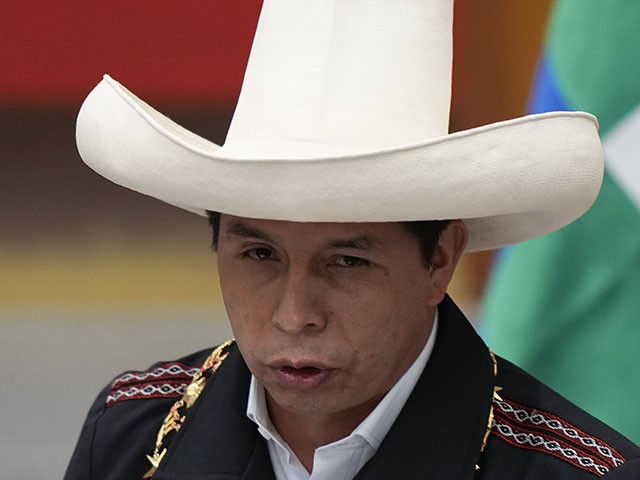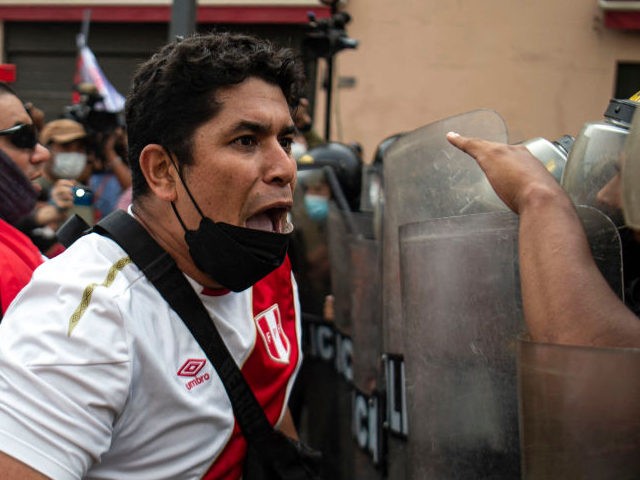The Peruvian government imposed a 22-hour-long curfew on Lima, Peru’s national capital, on Tuesday in an effort to quell violent protests against surging fuel and fertilizers costs in Peru directly tied to Russia’s latest war with Ukraine, Peru’s Gestión newspaper reported.
“The cabinet has agreed to declare a ban on the mobility of citizens from 2:00 a.m. through 11:59 p.m. of Tuesday, April 5 to protect the fundamental rights of all people,” far-left Peruvian President Pedro Castillo said in a nationally televised address broadcast just before midnight on Tuesday.
“After the announcement, the Supreme Decree was published in which this measure is formalized for 22 hours in a row, and only for Tuesday [April 5],” Gestión clarified.
“The president stressed that during this emergency period the constitutional rights related to the inviolability of the home, freedom of movement within the national territory, freedom of assembly and personal freedom and security are suspended,” the newspaper relayed.
President Castillo prematurely revoked Lima’s curfew order on April 5 before the action could take effect for the originally stated 22-hour period.

Peru’s President Pedro Castillo speaks at a ceremony after Bolivia’s president decorated him with The Great Cross of the Andes Condor at the Casa Grande del Pueblo presidential palace in La Paz, Bolivia, Saturday, October 30, 2021. (AP Photo/Juan Karita)
“From this moment, we are going to rescind this immovability order that corresponds to calling the Peruvian people to calm down,” the president said during a meeting of the Peruvian Congress. Castillo then alluded to heightened tensions on the part of protesters, suggesting demonstrators had ignored his original curfew edict and continued to gather across the national capital.
“The State is not going to endorse some attitudes that go beyond the constitutional, such as blocking roads, stoning homes, burning tires,” he detailed, as quoted by Peru’s La República newspaper.
The anti-government protesters’ defiant efforts seemingly spurred Castillo to repeal Lima’s curfew ahead of schedule on Tuesday.
Reuters witnessed “thousands of people” taking to Lima’s streets on April 5 in spite of the city-wide curfew. The noncompliance caused Castillo to “cut the curfew short just after 5 p.m. local time.”
Nationwide protests against Peru’s sky-high fuel and fertilizer costs spilled into their second consecutive week on April 4. Some of the widespread anti-government demonstrations have taken a violent turn over the past 14 days, prompting Castillo’s curfew order for Lima on April 5.
Protesters frustrated with the recent price surges “burned toll booths and clashed with police near the southern city of Ica” on April 4, according to Reuters. Peru’s federal government said at least four people had died as a result of the protests as of April 5.
Major unrest in Peru erupted on April 1 when farmers and truckers blocked some Peruvian highways to Lima. The blockade caused a sudden surge in food prices nationwide. The April 1 highway blockade began on March 28 when a group of truckers in central Peru’s Huancayo city went on strike to denounce rising fuel prices.
“Farmers and ranchers have also joined in the protests over the increase in the price of fertilizers, as well as citizens who demand a solution to the increased cost of living in the South American nation,” Canada’s Global News reported on April 2 of the Huancayo demonstration’s expansion.
Peruvian Finance Minister Oscar Graham responded to the public discontent on April 2 by announcing fuel and food tax cuts. Peru’s Ministry of Economy and Finance “decided to reduce a selective consumption tax for fuel by 90% and will propose a bill to exempt basic food items like chicken, eggs, flour and noodles from sales tax,” Graham said at the time.
Peru’s federal government issued an emergency declaration for the nation’s agricultural sector on March 20 in an effort to alleviate the impact of high fertilizer prices.
Reuters claimed on April 5 that Peru’s soaring fertilizer costs were “triggered by Western sanctions on Russia, a major exporter of potash, ammonia, urea and other soil nutrients.”
“Like many countries, Peru was already battling high inflation before the war. In March, inflation hit a 26-year high, largely driven by rising fuel and food prices,” according to the news agency.
Russia launched a war with neighboring Ukraine on February 24. The development took place shortly after the Kremlin announced on February 21 plans to formally recognize the independence of two Russian-supported breakaway states in eastern Ukraine’s territory of Donbas (the Donetsk and Luhansk People’s Republics, or DPR and LPR).

COMMENTS
Please let us know if you're having issues with commenting.